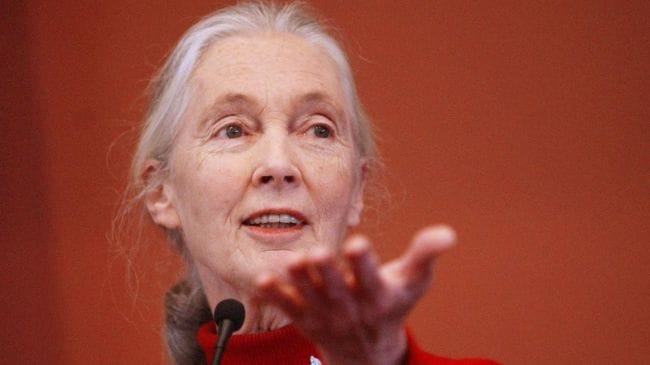Opinion When a giant falls: Goodbye, Jane Goodall. Thank you for the science and the compassion
As India celebrates National Wildlife Week, the death of the legendary primatologist and animal rights crusader marks the end of a transformative era in conservation
 Jane’s oeuvre is enormous and her passing leaves behind not only a huge void but also an incredible legacy of science, outreach and activism.
Jane’s oeuvre is enormous and her passing leaves behind not only a huge void but also an incredible legacy of science, outreach and activism. By Manoj V Nair
As India celebrates its 71st National Wildlife Week (October 2-10), reaffirming our collective commitment to protecting our natural heritage, the sad news of the demise of Jane Goodall, globally renowned scientist, conservationist, animal rights activist, and possibly the most famous naturalist-scientist of our times, has cast a pall of gloom. Her death on October 1 at the age of 91, while on a speaking tour in Los Angeles, indeed marks the end of an era.
Born in London on April 3, 1934, Jane’s lifelong love for animals was ostensibly triggered by a stuffed toy chimpanzee, Jubilee, which her father gifted her. Her deep interest in wild animals took her to Africa (she worked as a waitress to save up for a sea passage to Kenya) where she caught the eye of the celebrated anthropologist Louis Leakey who commissioned her to study wild chimpanzees, those elusive and apparently aggressive creatures whose biology and behaviour were then little known. She would later become famous as the first of the three “Leakey’s angels” or “trimates”, the pioneering trio of women primatologists who worked on the great apes — the other two being Dian Fossey and Birutė Galdikas, who studied the gorilla and the orangutan respectively. Arriving from England as a young woman of 26 at her remote rainforest camp at Gombe Stream Game Reserve in what is present-day Tanzania in July 1960, Jane continued to stay in Gombe till 1975, barring brief travels in between. Though shunned by the chimpanzees at first, her persistence and kindness finally paid dividends as an old male, christened David Greybeard, allowed her to approach closer and be part of his large family.
Her painstaking study (which still continues through her students), facing enormous logistical odds, threw open a window into the secretive lives of the chimpanzee, which along with the bonobo, is the nearest known relative of man, sharing a genetic similarity of 98.8 per cent. She discovered that chimpanzees were so much like humans – they had deep and affectionate social bonds, showed empathy and kindness, shared human emotions of pleasure, joy, sadness and fear. What more, they used tools, hunted down monkeys for meat and even waged wars. Further, each chimpanzee had its own personality, some of whom she gave names instead of numbers, at the risk of being branded as an anthropomorphist. Jane’s field research not only fetched her a Ph.D from the University of Cambridge in 1965, but also transformed our understanding of chimpanzees in a fundamental way, thereby redefining the very relationship between Homo sapiens and animals.
In her long and eventful life, Jane played several roles – the meticulous field biologist, a mentor and inspiration for generations of scientists especially women, a crusader for animal rights tirelessly espousing ethical treatment for animals, a global tour de force for compassion as an UN Messenger of Peace, a conservationist who started the Jane Goodall Institute in 1977 as a science-driven conservation organisation to help save the habitats of endangered animals by involving local people, and, most importantly, being a tireless spokesperson for awareness and education among children and youth through her Roots and Shoots programme (currently running in 100 countries, including India). In her long career, she authored numerous seminal scientific papers and about 27 books, including many for children. Later in life, she turned into the quintessential activist and educator, travelling nearly 300 days a year on speaking tours and public engagements, participating in TV shows, documentaries and podcasts. Much feted, the awards and prizes she received are too many to recount here, the latest being the Presidential Medal of Freedom given by President Joe Biden in January 2025.
Though I never had the fortune of meeting her personally, I vividly recall the deep impact her book In the Shadow of Man (1971) had on me when I was growing up in Trivandrum. Over the years, I have read many of her books including her last, The Book of Hope: A Survival Guide for Trying Times (co-authored with Douglas Abrams, 2021). Though numerous videos are available on YouTube, I would urge all to watch a talk titled “A Speech for History”, which she delivered at the UNESCO Headquarters in Paris on October 19, 2024.
Jane’s oeuvre is enormous and her passing leaves behind not only a huge void but also an incredible legacy of science, outreach and activism. The conservation firmament has indeed lost one of its brightest stars, but instead of mourning, we should celebrate her life, and in her own words, “try and give people hope, to help people understand that every single day we live, we can make a difference and together with everybody making a difference, we can change the world”.
Rest in peace, Jane and may you continue to inspire.
The writer is a naturalist and a member of the Indian Forest Service





